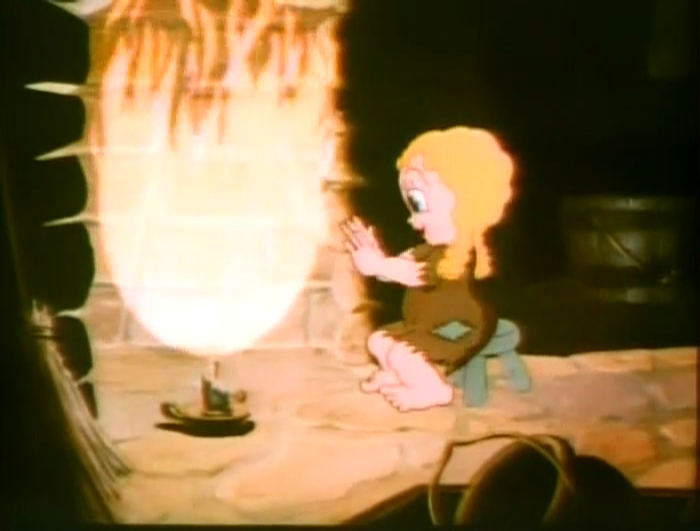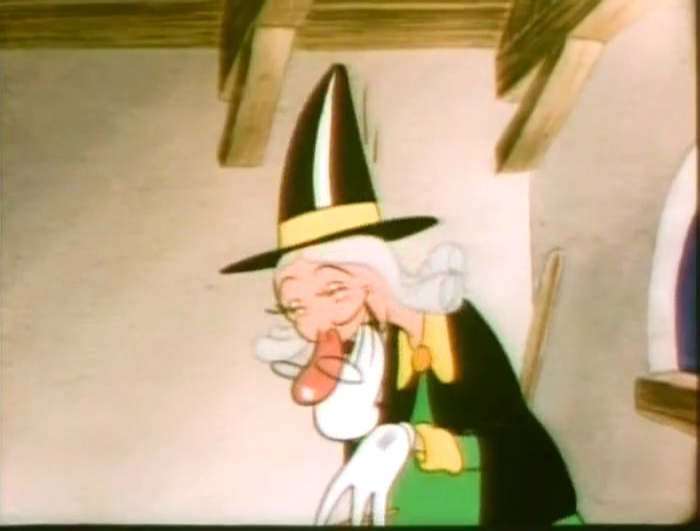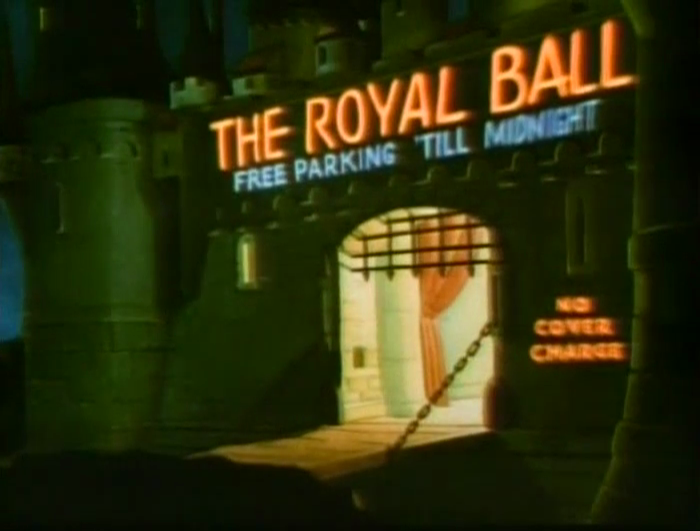DVD-Blu-Ray Availability: as a bonus feature on the Warner Home Video boxed set, The Busby Berkeley Collection, Vol. 2)
You may view this cartoon HERE.
With this cartoon, the Fred Avery unit enters a strong period. Accomplished film-making technique, coupled with improving animation and a tight core group of voice, music and graphic talent gives Avery's cartoons a sudden authority.
Avery the cartoon director seems assured and in control of his comedic notions. This assurance is cloaked in a self-effacing nonchalance. Not for Avery was the zany grandstanding of a Bob Clampett, nor the stylistic indulgence of a Chuck Jones.
Compare Cinderella Meets Fella to the previous year's Little Red Walking Hood, and Avery's pronounced and expanding skill is strongly felt. He is humbly in control of a comedic universe that bends to his whims, and delights in surprising and amusing its audience.
Like Walking Hood, this film uses the title card-as-storybook motif, and wastes no time getting down to business:
Avery is still a bit trigger-happy, and rushes to debunk the simulation of sincerity with a cheerfully corny post-script...
By 1938, there had been a few cartoon versions of the Cinderella story, so audiences knew what to expect--which gives Avery and his team a familiar world to subvert and wring out.
Cinderella, who at times resembles "Cookie" from the pre-Avery "Buddy" cartoon series, is seen doing exactly what her story demands--cleaning house for her trio of entitled step-sisters. They make one brief appearance to taunt our heroine:
The trio leans back in to invoke the radio-derived catchline "And I do... mean... YOU!"
A constant gag concept in Avery's world is the endowment of high technology on lowborn items.
In this instance, an old-school candle, given a control knob from a gas lantern, mechanically increases its output. The all-important deadpan approach makes this and its brethren gags work.
Cinderella has the flame set to "Arsonist's Wet Dream" intensity, and cheerfully warms herself.
Cinderella, upon realization of the time, does a flying take and rushes to the phone.
She reports her Fairy Godmother as MIA, and exhorts the police, in un-ladylike tones: "GO GET 'ER, BOYS!"
We cut to a piece of stock animation we'll see again in later Avery cartoons. Avery loved to both use and josh the montage techniques of live-action films. He imitates them very well, and these touches enliven his late '30s Schlesinger cartoons.
Cinderella next approaches her radio, which must be a 1938 Philco Model 38-4XX set...
Cindy repeats, out of order, the advertising catch-phrase for this revolutionary radio:
Dying to know more about this elderly piece of technology? Here. And now back to our analysis...
Cinderella picks up the police radio wavelength. As in the earlier I Love To Singa (1936), interactive radio informs this heroine. Of their pursuit of the missing Fairy Godmother, the cops announce they'll "search every beer joint" 'til she's uncovered. (Keith Scott informs me that this voice is by the director himself. While we're at it, Berneice Hansell is the typically unctuous voice of Cinderella.)
Oh, here's something funny. One imagines the "beer joint" comment wasn't in jest!
Enter--on her laurels--one of the most delightful minor characters in Avery's q.v.
We now segue to the second set-piece of this sumptuous cartoon:
That signature song is replaced by "Boy Meets Girl," which is (Keith Scott, again!) sung by the Paul Taylor Choristers. This is unusual turf for Avery, and he tucks a few signature gags into the sentiment.
Just in time, the Cinderella story trope chimes in... it's midnight!
Cinderella's matter-of-fact return to drop her shoe, and Egghead's resultant chagrin, are priceless moments.
HE: Let's go back in the 10th row an' stay for the newsreel!
Cinderella Meets Fella is a product of sophisticated thinking and film-making. Its sure grasp of technique, married to a sarcastic and daring comic vision, is the foundation for one of Tex Avery's first fully realized animated cartoons. From the A-team voice talent, to Carl Stallings' referential musical score, to consistently good and attractive animation, this film is Avery (and his unit) in top form.
Note, in the lobby card to your right, that Egghead is named "Elmer." Note, as well, how much smaller his nose is, in this after-the-fact promotional image, than in the cartoon proper.
He is very much Egghead in this cartoon, in deportment, mentality and appearance. He will soon be given the name of Elmer Fudd, and his Penner-derived traits elided, just as Avery has figured out what to do with him.
With this cartoon, Tex Avery reached a long-sought union of front-office pleasing content and director-pleasing context. Given the lower budgets of Schlesinger-produced cartoons, the spectacle of this film is impressive--and appropriately used. Despite the intrusions of several spot-gag cartoons, Avery is in one of his finest eras as a filmmaker and comedian.
________________________________________
*Devon Baxter informs me that this wasn't a new bit: "A character stopping the clock from striking 12 in a Cinderella story was used in A KICK FOR CINDERELLA, a 1926 Mutt & Jeff." Thank you, Devon!
UP NEXT: Elmerhead rides again in A Feud There Was.
The trio leans back in to invoke the radio-derived catchline "And I do... mean... YOU!"
Cinderella is typically crestfallen.
An incongruous shout of "Hi-yo Silver!" again trounces the put-on sentiment of this stock moment. We fade to black, then up again to another trope of Disney-school heart-tuggers, as Cinderella shivers in the cold, and attempts to warm herself in the glow of a lone candle.A constant gag concept in Avery's world is the endowment of high technology on lowborn items.
In this instance, an old-school candle, given a control knob from a gas lantern, mechanically increases its output. The all-important deadpan approach makes this and its brethren gags work.
Cinderella has the flame set to "Arsonist's Wet Dream" intensity, and cheerfully warms herself.
Fate interrupts, in the form of an OCD cuckoo clock:
The absurdity of this clock having eight cuckoos is compounded as they shout,
in angry unison: "It's 9:00!"
Cinderella panics, and introduces the concept of quiet pre-destination so rampant in Avery's comedic world. The future is already known, and things meant to happen need to occur on schedule.Cinderella, upon realization of the time, does a flying take and rushes to the phone.
We cut to a piece of stock animation we'll see again in later Avery cartoons. Avery loved to both use and josh the montage techniques of live-action films. He imitates them very well, and these touches enliven his late '30s Schlesinger cartoons.
Cinderella next approaches her radio, which must be a 1938 Philco Model 38-4XX set...
Cindy repeats, out of order, the advertising catch-phrase for this revolutionary radio:
"No squat...
"no squint...
"no stoop!"
She seems mighty tickled with her up-to-date cultural reference. Here's the actual ad-campaign:Dying to know more about this elderly piece of technology? Here. And now back to our analysis...
Cinderella picks up the police radio wavelength. As in the earlier I Love To Singa (1936), interactive radio informs this heroine. Of their pursuit of the missing Fairy Godmother, the cops announce they'll "search every beer joint" 'til she's uncovered. (Keith Scott informs me that this voice is by the director himself. While we're at it, Berneice Hansell is the typically unctuous voice of Cinderella.)
Police action.
One of my favorite shots in any Fred/Tex Avery cartoon. That rubbery van; the moody nightscape. It's not funny, but it's a great visual.Oh, here's something funny. One imagines the "beer joint" comment wasn't in jest!
Enter--on her laurels--one of the most delightful minor characters in Avery's q.v.
"What the... I hope I didn't break my appointment!"
is one of the best entrance lines in all of motion picture history.
As voiced by Elvia Allman, according to cartoon voice expert Keith Scott, The FG is gifted with one of the most entertaining and colorful voice performances in Avery's cartoon career. Her short time on-screen, here, is lamentable.
In Avery's world, things are seldom misplaced.
Anything of importance is prominently labeled.
A sarcastic snatch of "She Was an Acrobat's Daughter" accompanies the reveal of the bottle o' hootch that is, perhaps, FG's off-duty "magic wand."
"Oh--pardon ME!"
Second excavation delivers the goods.
Steel guitar swoops make up the audio half of the special effects here.
Cinderella likes her ball-going outfit.
"Now first, a pumpkin for the coach!"
Again, a gag is based on the concept of embedding old within new.
The can's redundancy is genuinely funny.
Mice-as-coachmen needed. Thus, Avery dips back into his first Schlesinger cartoon for a slot-machine gag.
Jodphurs are always funny.
(from Gold Diggers of '49, 1935)
The gag is prolonged, and highly refined, three years later.
Dazed mice tumble out.
Second transformation is a screwball flop; FG reacts with full body take.
Irv Spence animates the personality close-up: "Oh, I guess I got my dates mixed!"
Mistake fixed...?
Nope.
"Hmmm...
"Well, I guess it'll have to do!"
The Fairy Godmother's amusement in her mistakes and public humiliations is refreshingly original. Accepting unexpected outcomes is part of Avery's universe, so a stagecoach it is...
Avery's gag mind is inspired in this cartoon. Like Jacques Tati, Avery had the gift to imagine new uses for conventional items. In this case, the cottage front suddenly doubles as a garage door.
Obligatory multiplane mood scene follows.
These two images from Jacques Tati's 1971 film Trafic demonstrate his similar, playful vision that things have more than one purpose.We now segue to the second set-piece of this sumptuous cartoon:
Again, the application of modern flourish to old-school image produces an ironic chuckle.
Inside is a scene of an order and courtliness seldom seen in Avery's work. His temporary embrace of Disney-esque storybook settings proves an effective duck-blind for his intrusive, invasive comedy.
Inside is a scene of an order and courtliness seldom seen in Avery's work. His temporary embrace of Disney-esque storybook settings proves an effective duck-blind for his intrusive, invasive comedy.
Heralds herald Cinderella's approach...
...and, hearing the prominent clop of hooves, revive a gag from Avery's prior picture, The Isle of Pingo-Pongo--albeit in less discomforting form. A strident rendition of "She'll Be Comin' 'Round the Mountain" is as ill-suited for a fairy tale as it was for stereotyped black cannibals. Must have tickled Avery to do this.
Cinderella's approach down the staircase is Disney-worthy...
...until a royal entourage of lechers break the mood with their as-one whistle and excited call of "Ba....by!"
Undaunted, Cinderella continues, in multiplane splendor.
Her entrance is met with admiring applause...
...then superseded by a second entrance-of-note...
Prince Charming! A royal carpet-on-carpet is rolled out for his debut.
Egghead, as the Prince, pops out of the unfurled rug. Here, he's voiced by Dave Weber (not Cliff Nazarro--thanks once again, Keith Scott, for this information!) Weber does a spot-on impression of Joe Penner, a comedian I've profiled in previous blog entries.
E-head chuckles idiotically at us...
Then tips his hat, in Avery fashion.
Cinderella catches his eye. Weber's vocal performance is also endearing--this is the most appealing Egghead gets in his short existence.
"What a bee-you-tee-ful girl!"
"Huh huh huh..."
"I can't get over it..."
Keith Scott, again: "Carl Stalling adds a tiny Joe Penner reference...as Egghead approaches the Princess in the ballroom the music plays a brief snatch of Penner's theme song "When the Pussy Willow Whispers to the Catnip."That signature song is replaced by "Boy Meets Girl," which is (Keith Scott, again!) sung by the Paul Taylor Choristers. This is unusual turf for Avery, and he tucks a few signature gags into the sentiment.
Cinderella's lipstick speaks the truth Egghead can't summon...
"Oh, boy!"
Egghead is startled by this outburst.
They dance, and without missing a beat, Avery works in a wacky-yet-charming sight gag:
Here it is, pieced together. The camera moves from right to left--
a common Avery choice in this period.
Egghead utters that catch-phrase from the recent Humphrey Bogart picture, Dead End: "Look, fellas! I'm dan-cin'! See? I'm dan-cin'!"
Inspired by the music, he whispers a suggestion in his date's ear...
...which she accepts.
Silhouetted on a balcony, E and C enjoy an intimate moment, in which they forget they're cartoon characters, being viewed by millions.Just in time, the Cinderella story trope chimes in... it's midnight!
The cuckoo, hep to the storyline, struggles to delay the inevitable--in one of the funniest such metaphors that ever appeared in mass media.*
Unaware, E and C dream of wedded bliss (animated by Irv Spence)...
...as the bird concedes with a "whaddaya gonna do?" shrug.
His failure merits a medium shot.
Beautifully animated by Spence, the following piece of high-functioning personality animation adds depth to a tiresomely familiar moment.Cinderella's matter-of-fact return to drop her shoe, and Egghead's resultant chagrin, are priceless moments.
Amidst re-used ballroom animation, exasperated E pursues crestfallen C...
We fade to black, and fade in on what must be a considerable time later.
As Egghead, David Weber lets loose with some prime Penner-isms as our hero
searches for his lost love...
This must be where the Fairy Godmother was intercepted!
Sequence ends in a sublime Avery moment, as the location of Cinderella's house
becomes absurdly self-evident, to dullard Egghead's puzzlement.
Again with the neon signs!
"You know...this must be Cinderella's house."
Inside, Egghead continues his frenzied search...
Never one to waste a good gag, Avery returns to the 9-in-1 cuckoo clock, which chides Egghead en masse: "Now you KNOW she wouldn't be in HERE."
Egghead has been through a lot in this cartoon.
He then espies a fateful document and we both read it...
Note (a) Egghead's now creepy-realistic hands (with nails);
(b) a bold meta-moment that slapped period audiences up-side
the head. The note suggests that (c) Egghead took a long
time to search and (d) that, in this world, theaters have 2:30 AM shows.
This is too much data input for Egghead; his internal hard drive crashes.
His woeful wail is ended by a silhouette, from the theater audience:
"Oh, Princey! Here I am! Here I am in the 10th row!"
In this cartoon Orpheus, Cinderella departs the realm of observer and
returns to the very film she just viewed.
SHE: What do we do now?returns to the very film she just viewed.
HE: Let's go back in the 10th row an' stay for the newsreel!
His wanna-buy-a-duck hyuk-hyuks punctuate the soundtrack as the happy couple steps through the closing iris and become the viewers of their own film.
Note, in the lobby card to your right, that Egghead is named "Elmer." Note, as well, how much smaller his nose is, in this after-the-fact promotional image, than in the cartoon proper.
He is very much Egghead in this cartoon, in deportment, mentality and appearance. He will soon be given the name of Elmer Fudd, and his Penner-derived traits elided, just as Avery has figured out what to do with him.
Egghead is enjoyable here, for the first time in his checkered career--in large part due to Weber's ace voicing, and Spence's delicious animation--but Avery is already tired of him. He'll continue to use Elmerhead (as he'll be called henceforth here) for a few more cartoons, but this engaging star turn will never be equaled.
As we grow further away from the pop-culture references that pepper Avery's Schlesinger cartoons, the efforts of a historian are required to explain what certain punchlines, characters and voicings really mean. I'm ever-thankful of the input of scholars such as Keith Scott and Mark Kausler in helping me provide context for these long-gone signifiers. Though the references, themselves, may be meaningless to 21st century viewers, the vigor and confidence in which they're delivered is still fresh and funny.
With this cartoon, Tex Avery reached a long-sought union of front-office pleasing content and director-pleasing context. Given the lower budgets of Schlesinger-produced cartoons, the spectacle of this film is impressive--and appropriately used. Despite the intrusions of several spot-gag cartoons, Avery is in one of his finest eras as a filmmaker and comedian.
________________________________________
*Devon Baxter informs me that this wasn't a new bit: "A character stopping the clock from striking 12 in a Cinderella story was used in A KICK FOR CINDERELLA, a 1926 Mutt & Jeff." Thank you, Devon!
UP NEXT: Elmerhead rides again in A Feud There Was.























































































































































































































Terrific post as always Frank! Again, the Stepsisters remark: ".. And we do mean YOU!" is taken from Hollywood commentator Jimmy Fidler. The "Oh Boy" line that the lipstick on Egghead's nose utters is a parody of Martha Raye, who used her "Oh Boy" and "Yeh, Man" lines to enhance her swing era persona. All us Penner fans would like to correct the title of his theme song, it's "When the Pussywillow whispers to the CATNIP" not Catfish. Joe often ended his radio shows with this little song, "When the Pussywillow whispers to the Catnip, (Psst Psst), We'll be back together again!" Do another post soon, Frank, I can't get over it, It's AMAAAZING!
ReplyDeleteThank you, Mark! I've corrected the Penner theme in the main body of the article. Your kind words are greatly appreciated by this humble writer. I just finished re-watching "Monsieur Verdoux," speaking of Martha Raye. I'm hoping to make these posts more regular, especially since we're in a really good stretch of Avery's WB films.
Delete